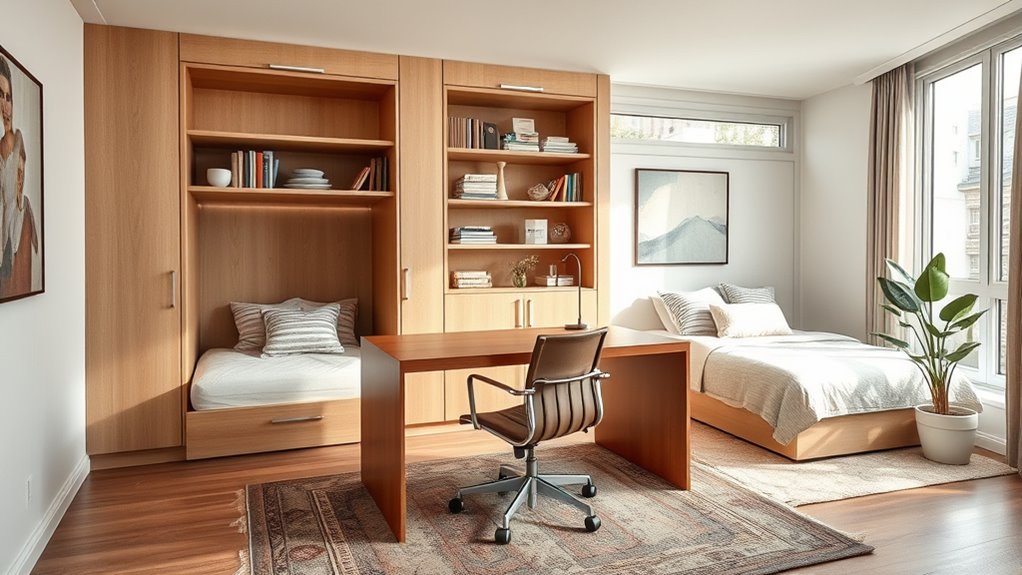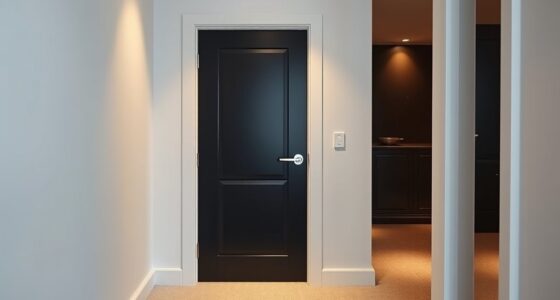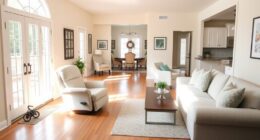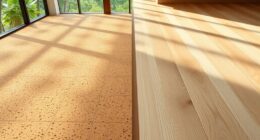To maximize your space, consider designing a versatile room that easily switches between a home office and guest room. Use convertible furniture like fold-away beds or Murphy desks to save space, and incorporate smart storage solutions to keep things organized. Prioritize ergonomic setups for work and cozy comfort for guests. With thoughtful planning and adaptable furniture, you can create a functional, multi-use space. Keep exploring for tips to perfect your dual-purpose room even further.
Key Takeaways
- Prioritize flexible furniture like fold-away desks and Murphy beds to seamlessly switch between work and guest functions.
- Use ergonomic setups and proper lighting to enhance productivity and comfort in multi-purpose home offices.
- Incorporate smart storage solutions to keep the space organized and adaptable for both work and guest needs.
- Design the room with neutral or versatile decor to easily transition between professional and guest-friendly atmospheres.
- Optimize layout by clearly defining zones for work and relaxation, ensuring functionality without clutter.
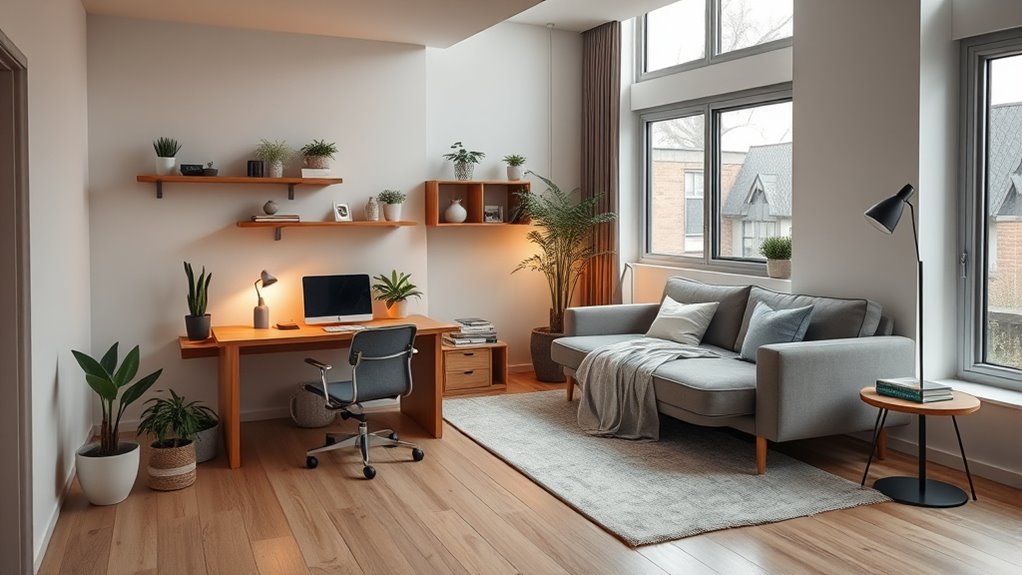
As remote and hybrid work become the norm, more homeowners are prioritizing dedicated workspaces over guest rooms. This shift reflects a growing recognition that a functional home office offers daily value, whereas guest rooms tend to be used less frequently. Industry experts agree, with 91% of top U.S. interior design and home staging professionals noting that extra space is more likely to be allocated for a home office in 2024. The trend has gained momentum since 2020, fueled by the rise of remote and hybrid work arrangements that make having a dedicated workspace essential. You might find yourself converting a spare bedroom into an office to better accommodate work-from-home needs, especially since these spaces often double as study areas for children or other household tasks, boosting their utility.
Home offices are becoming a priority, replacing guest rooms with multifunctional, productive spaces.
The demand for multi-use rooms is increasing, with about 26% of American families now having a dedicated home office, up from 20%. Despite the record number of excess bedrooms—around 31.9 million nationally—fewer are being used solely as guest rooms. Instead, these rooms are transforming into functional workspaces, a trend driven by factors like rising commuting costs, childcare considerations, and transportation challenges. Homeowners are also leveraging other parts of their homes—such as living rooms, master bedrooms, and dining areas—as flexible work locations, further emphasizing the importance of adaptable spaces. Your home’s layout now often reflects this shift, with multifunctional rooms becoming the norm.
Designing these versatile spaces presents challenges, but innovative solutions help maximize their potential. While multifunctional rooms are popular, one function typically dominates—most often the home office. Homes not originally built for remote work can pose ergonomic issues, leading about a quarter of remote workers to struggle with inadequate workspace. To address this, ergonomic furniture becomes a priority. Convertible furniture like Murphy beds or fold-away desks allows for seamless transitions between an office and guest accommodation, saving space and maintaining comfort. Incorporating clever storage solutions helps keep these rooms organized and adaptable, allowing you to switch between work and guest use with ease. Additionally, understanding the contrast ratio of your projector can significantly improve your home cinema setup, especially in multi-use spaces where lighting conditions vary.
Frequently Asked Questions
How Can I Incorporate Storage Solutions for Both Uses?
You can incorporate storage solutions by choosing versatile furniture like Murphy beds or daybeds that double as seating. Use vertical and floating shelves to keep items organized without clutter. Under-bed storage and storage benches help maximize space for both work and guests. Install hooks for hanging belongings, and opt for modular pieces that move easily. Combining these options guarantees your space stays functional and tidy, regardless of its current use.
What Lighting Options Suit Dual-Purpose Rooms?
They say, “Light is the key to a room’s soul,” and you can make your space versatile with smart lighting options. Use layered lighting—overhead, task, and accent lights—to suit different needs. Dimmable fixtures and adjustable color temperatures help create the right mood, whether you’re working or relaxing. Incorporate energy-efficient LEDs and consider smart systems for easy control, making your room both functional and inviting.
How Do I Choose Furniture That Works for Both Functions?
When choosing furniture for a multi-use space, you should prioritize versatility and space-saving features. Opt for pieces like sofa beds, Murphy beds, or convertible sofas that serve dual functions. Modular furniture lets you reconfigure layouts easily. Incorporate hidden storage to reduce clutter and preserve space. Select compact, built-in desks and ergonomic chairs to create a functional workspace. Use strategic placement and neutral designs to guarantee the furniture suits both your work and guest needs seamlessly.
Are There Privacy Considerations for Shared Spaces?
Did you know that 65% of people say privacy is their top concern in shared spaces? When designing your shared room, you should consider privacy carefully. Use room dividers, curtains, or screens to create separate zones. Strategic furniture placement and private corners help maintain intimacy. Plus, adjustable lighting and smart storage make certain each area feels distinct, making the space comfortable for both work and relaxation.
What Are Cost-Effective Ways to Redesign This Space?
When redesigning a space cost-effectively, focus on multifunctional furniture like futons or Murphy beds that serve dual purposes. Use DIY solutions like built-in benches or repurpose existing furniture to save money. Maximize natural light and keep the color scheme neutral to make the room feel larger. Incorporate affordable storage options like wall-mounted shelves and baskets to reduce clutter. These strategies help you create a flexible, budget-friendly space.
Conclusion
Balancing a home office and guest room can seem tricky, but with smart planning, you can make both work seamlessly. Did you know that 60% of homeowners now prioritize multi-use spaces? By choosing versatile furniture and clever storage, you create a room that suits your work needs while welcoming guests effortlessly. With a little creativity, you’ll enjoy a functional space that adapts to your lifestyle, making every square foot count.
